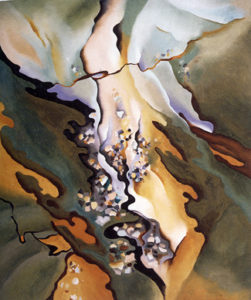Poor Georg ia O’Keeffe. She lived so long and was so beloved that her paintings became cliches. Where museum-goers once gasped, seeing female anatomy in her flower paintings, they now just nod and quietly congratulate themselves for at least understanding this example of modern art. This example, after all, is reproduced on millions of posters and calendars.
ia O’Keeffe. She lived so long and was so beloved that her paintings became cliches. Where museum-goers once gasped, seeing female anatomy in her flower paintings, they now just nod and quietly congratulate themselves for at least understanding this example of modern art. This example, after all, is reproduced on millions of posters and calendars.
Now the Whitney Museum has put together a retrospective it hopes will rescue O’Keeffe from her own reputation. “Georgia O’Keeffe: Abstraction” is a show of ideas, not classic images. It’s got flower paintings, all right, but these flowers, the curators proudly point out, are more symbolic of the male anatomy. Let’s hear it for the men, and for the show, which is an excellent one.
O’Keeffe’s career had a unusual trajectory. Many 20th century painters began as realists and later converted to abstraction. O’Keeffe did the opposite. Her first serious works were completely non-representational, then, over decades, she let more and more of the world into her canvases.
The charcoal drawing titled “Early Abstraction” (1915), represents nothing but itself: a dynamic upward sweep, like a curling wave. You see this curling form again and again in this show, sometimes coiling into a tight spiral, other times standing up on a stalk, like a fiddlehead fern.
Unlike the cubists and many subsequent generations of abstract artists, O’Keeffe never submitted to a system. She followed a more intuitive path. She felt her way along, intrigued with the problem abstraction presented. Where did you start? What guided your hand? Could you paint a pure feeling? She tried with a “portrait” of photographer Paul Strand and ended up with a rather unflattering form that looks like a column of red and black smoke.
Almost immediately she paired up with photographer Alfred Stieglitz, a lightning rod for avant garde currents in America. He gave O’Keeffe her first show at his 291 Gallery, fell in love with her, divorced his wife, and married her. They stayed married until his death in 1946. As can be seen here, Stieglitz loved photographing O’Keeffe. She had plain, masculine features, large, expressive hands and the figure of a Greek statue. She appears alternately in severe black clothes and in the nude. Their eroticism caused quite a stir and reinforced the belief that O’Keeffe’s art was all about feminine sexuality.
This show sticks to its more high-minded theme. Although a few drawings show O’Keeffe experimenting with the sharp edges of cubism, her vocabulary of form favored the organic and the natural. Her shapes can remind you of tongues, stamens, buds, split seeds, sprouts, clouds, moons, suns, membranes and swirling water. They are animated by the force and thrust of growth and natural processes.
She wanted nothing to do with the drab grays and browns of the cubists. O’Keeffe embraced color, using a rainbow palette that she often thinned and applied in overlapping veils that draw you into the painting. A painting like “Spring” (1922), is bursting with life. Plant forms rise from the bottom of the painting and a cloud billows up.
O’Keeffe could be enigmatic. A painting that clearly looks like a close-up of an eye and iris is titled “At the Rodeo.” But that’s the exception. What makes O’Keeffe so accessible as an artist is that she refused to draw a line between abstraction and representation, maintaining that even the staunchest realist was doing an interpretation of reality. This ultimately led to those magnified flowers, shells, rocks and animal bones for which she is best known. But that’s what you always see at an O’Keeffe show and this show, thankfully, doesn’t want to go there.
It stays the course, concluding, touchingly with some very simple gestural paintings from the late ‘70s. They are just a few strokes of the brush, like Japanese Zen paintings. She was in her nineties by then (she died in 1986 at 99), and required the help of an assistant to mix the paint and load the brush.

